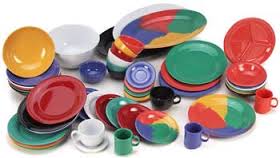
With their vibrant colors and breakage resistance, melamine plates, bowls, and cups are becoming popular. A number of previous studies suggest that heat and acid can cause melamine from dinnerware to seep into food ? leading to increased risks of urinary stones and kidney problems. Ming-Tsang Wu, from Kaohsiung Medical University (Taiwan), and colleagues propose that a substitution can dramatically reduce this potential exposure problem. The researchers first measured melamine levels in the urine of study subjects and then substituted stainless steel boxes and silverware for their hot meals. The melamine levels in their urine decreased after using the containers by as much as 92%. The study authors write that:” Regular use of stainless steel-made meals boxes can mitigate melamine exposure from melamine tableware.”
In 2008, the health effects of acute melamine exposure became widely known when a scandal erupted in China over the material’s use in milk powder. About 300,000 people were sickened, and more than 50,000 babies were hospitalized. Although officials largely stamped out the practice of adding melamine to food, most people continue to be exposed to the substance, an industrial chemical also used in other plastics, flooring and whiteboards. Some research has suggested that even small amounts could increase the risk of urinary stones or kidney problems, and one major source of the material is tableware. Ming-Tsang Wu and colleagues wanted to see what kinds of practices could lower people’s exposure.
The researchers first measured melamine levels in the urine of study subjects and then gave them stainless steel boxes and silverware for their hot meals. The melamine levels in their urine decreased after using the containers by 41 to 92 percent. The wide range could be due to subjects’ exposure to other uncontrolled sources of the substance, the researchers say.





